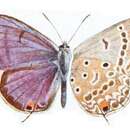en
names in breadcrumbs


Lepidochrysops quassi, the tailed blue giant Cupid, is a butterfly in the family Lycaenidae. It is found in Ivory Coast, Ghana, Togo, Nigeria and Cameroon.[2] Its habitat consists of open areas in the forest zone.
Adults have been recorded on wing in August and September and from June to November.
The larvae feed on Solenostemon ocymoides and probably also on Ocimum species. They are associated with the ant species Camponotus maculatus.
Lepidochrysops quassi, the tailed blue giant Cupid, is a butterfly in the family Lycaenidae. It is found in Ivory Coast, Ghana, Togo, Nigeria and Cameroon. Its habitat consists of open areas in the forest zone.
Adults have been recorded on wing in August and September and from June to November.
The larvae feed on Solenostemon ocymoides and probably also on Ocimum species. They are associated with the ant species Camponotus maculatus.